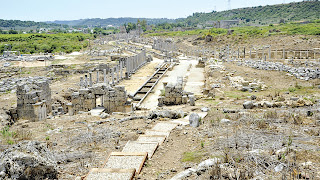In spite of all the excavations, explanations, and reconstructions, we still cannot really imagine what a city like Perge must have looked like during its
heyday. Walking through the wonderful collection at the Museum of Antalya
No less than 13 rare sculptures have been
unearthed at Perge’s necropolis at the end of the western street. In a
Nymphaeum close to the northern baths, a complete statue of Emperor Caracalla, nearly 2.20m high, was found, the only complete
one so far. Also, a 1.30m tall sculpture of a horse with perfect anatomical
details was recovered in the area.
And then an impressive number of Greek gods and
goddesses have been deterred as well: a 2-meters-high Selene, the moon goddess
and sister of the sun god Helios; a strong and handsome Helios venerated on the
same level as Apollo; a 1.70m high statue of Nemesis in a transparent dress; a
statue of Tyche, the Latin Fortuna; a great Asclepius, god of medicine and
health holding a plate of medicine in his right hand and a ferula plant in his
left; a reassembled Aphrodite (since she was found in bits and pieces), the
goddess of love and beauty; and an armored and finely sculptured Athena, the
goddess of peace and intelligence. Last but not least, there was a headless
statue of a woman in a long dress and coat, that of a headless man holding a
sword, and finally, the statue of a priest holding a horn-of-plenty in his right
hand and showing two snake reliefs on his neck.
All these beauties have meanwhile made their
appearance in a new Perge Hall at the Archaeological Museum of Antalya.
Time to return for a new visit to the museum as well as to the site of Perge itself, since, according to the
picture released in the Hurriyet
Daily News, more of the ancient city has been cleared, including the
hill behind the main fountain that leads to the acropolis.



No comments:
Post a Comment